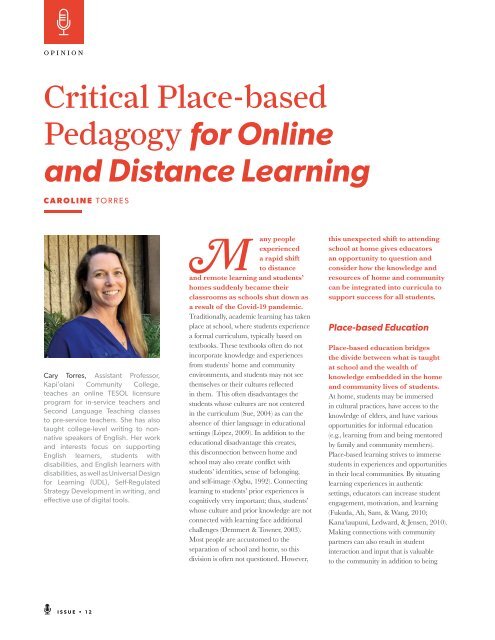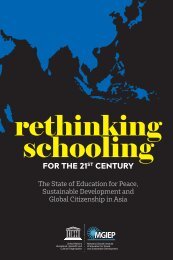The Blue DOT - 12: Reimagining Learning Spaces for Uncertain Times
You also want an ePaper? Increase the reach of your titles
YUMPU automatically turns print PDFs into web optimized ePapers that Google loves.
OPINION<br />
Critical Place-based<br />
Pedagogy <strong>for</strong> Online<br />
OPINION<br />
and Distance <strong>Learning</strong><br />
CAROLINE TORRES<br />
Cary Torres, Assistant Professor,<br />
Kapi’olani Community College,<br />
teaches an online TESOL licensure<br />
program <strong>for</strong> in-service teachers and<br />
Second Language Teaching classes<br />
to pre-service teachers. She has also<br />
taught college-level writing to nonnative<br />
speakers of English. Her work<br />
and interests focus on supporting<br />
English learners, students with<br />
disabilities, and English learners with<br />
disabilities, as well as Universal Design<br />
<strong>for</strong> <strong>Learning</strong> (UDL), Self-Regulated<br />
Strategy Development in writing, and<br />
effective use of digital tools.<br />
M<br />
any people<br />
experienced<br />
a rapid shift<br />
to distance<br />
and remote learning and students’<br />
homes suddenly became their<br />
classrooms as schools shut down as<br />
a result of the Covid-19 pandemic.<br />
Traditionally, academic learning has taken<br />
place at school, where students experience<br />
a <strong>for</strong>mal curriculum, typically based on<br />
textbooks. <strong>The</strong>se textbooks often do not<br />
incorporate knowledge and experiences<br />
from students’ home and community<br />
environments, and students may not see<br />
<br />
in them. This often disadvantages the<br />
students whose cultures are not centered<br />
in the curriculum (Sue, 2004) as can the<br />
absence of thier language in educational<br />
settings (López, 2009). In addition to the<br />
educational disadvantage this creates,<br />
this disconnection between home and<br />
<br />
students’ identities, sense of belonging,<br />
and self-image (Ogbu, 1992). Connecting<br />
learning to students’ prior experiences is<br />
cognitively very important; thus, students’<br />
whose culture and prior knowledge are not<br />
connected with learning face additional<br />
challenges (Demmert & Towner, 2003).<br />
Most people are accustomed to the<br />
separation of school and home, so this<br />
division is often not questioned. However,<br />
this unexpected shift to attending<br />
school at home gives educators<br />
an opportunity to question and<br />
consider how the knowledge and<br />
resources of home and community<br />
can be integrated into curricula to<br />
support success <strong>for</strong> all students.<br />
Place-based Education<br />
Place-based education bridges<br />
the divide between what is taught<br />
at school and the wealth of<br />
knowledge embedded in the home<br />
and community lives of students.<br />
At home, students may be immersed<br />
in cultural practices, have access to the<br />
knowledge of elders, and have various<br />
opportunities <strong>for</strong> in<strong>for</strong>mal education<br />
(e.g., learning from and being mentored<br />
by family and community members).<br />
Place-based learning strives to immerse<br />
students in experiences and opportunities<br />
in their local communities. By situating<br />
learning experiences in authentic<br />
settings, educators can increase student<br />
engagement, motivation, and learning<br />
(Fukuda, Ah, Sam, & Wang, 2010;<br />
<br />
Making connections with community<br />
partners can also result in student<br />
interaction and input that is valuable<br />
to the community in addition to being<br />
relevant to the students (Powers, 2004). <strong>The</strong>re is an increasing<br />
amount of evidence demonstrating that students’ resilience and self-<br />
<br />
their lives and cultures because it works to allay negative schooling<br />
experiences and marginalization. Furthermore, these advantages<br />
<br />
<br />
from more than teaching about the place and culture, place-based<br />
education is teaching through the place and culture. It emphasizes<br />
building connections with local communities and integrating<br />
students’ cultural backgrounds and values into curriculum. This<br />
can, and often does, include incorporating indigenous knowledge,<br />
which places importance on making sense of the world, through a<br />
lens of interconnectedness (Kincheloe, 2007). Place-based learning<br />
is rooted in the interconnectedness of people and place and as such<br />
can play an important role in integrating culture, community, and<br />
indigenous knowledge as a cornerstone of curricula and instruction.<br />
A Critical Place-Based Approach<br />
Teachers may hesitate to engage in place-based education<br />
because they may be experts in math, science, or other<br />
disciplines and may not feel as though they know enough<br />
about the culture and communities of their students –<br />
whether or not they are members of those same communities.<br />
However, teachers do not have to be knowledgeable in all aspects<br />
of culture to engage in place-based education with their students.<br />
In fact, implementing place-based education through the lens of<br />
critical pedagogy centers community knowledge and collaboration.<br />
Critical pedagogy is a problem-posing approach that allows<br />
learners to tap into their own knowledge and co-investigate with<br />
<br />
own communities and lives. It also challenges teachers to become<br />
learners and learners to become teachers through instructional<br />
conversations (Friere, 2018). Thus, the teacher does not need<br />
to, nor should, be the all-knowing expert but instead facilitates<br />
a journey of discovery and learning. Student success is not only<br />
dependent on what the teacher does, what the student does is also<br />
important (Ogbu, 1992); thus, the student as teacher role provides<br />
valuable opportunities <strong>for</strong> students to use their own knowledge<br />
in a meaningful way. A critical place-based approach to learning<br />
can also empower and engage students by encouraging them to<br />
advocate <strong>for</strong> the places and practices that they are grounded in,<br />
including the impact of historical injustices, like colonization, on<br />
their places and communities (Porter & Cristobal, 2018). This<br />
goes beyond simply using culturally relevant examples with typical<br />
textbook materials (which is often called culture or place-based<br />
education) by giving students opportunities to engage critically with<br />
issues and policies impacting their communities (Ladson-Billings,<br />
2014), schools, and education. Place-based education centers<br />
students’ communities and lived experiences as an integral part<br />
of the curriculum and not only a legitimate but valued part of the<br />
learning experience. In turn, students have a context <strong>for</strong> learning<br />
that is grounded in their communities while also situated in the<br />
global context.<br />
ISSUE • <strong>12</strong><br />
4 1


















